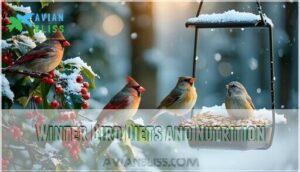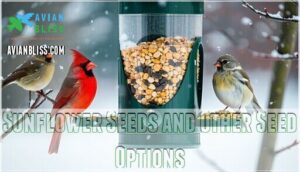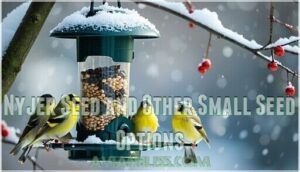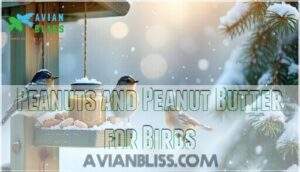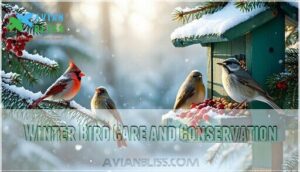This site is supported by our readers. We may earn a commission, at no cost to you, if you purchase through links.
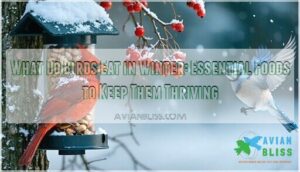
You’ll find them seeking high-fat options like seeds from pine, spruce, and maple trees, plus persistent berries from sumac, dogwood, and elderberry plants.
They hunt for protein-rich insects hiding under bark or in leaf litter.
Many backyard birds thrive on supplemental feeding – black oil sunflower seeds, nyjer, peanuts, and suet provide essential fats when their metabolism works overtime to stay warm.
Natural food sources become scarce, making energy-rich nutrition critical for maintaining body heat and surviving freezing temperatures.
Smart feeding strategies can mean the difference between thriving and merely surviving for your feathered neighbors.
Table Of Contents
- Key Takeaways
- Winter Bird Feeding Basics
- What Do Birds Eat in Winter
- Winter Bird Diets and Nutrition
- Essential Winter Bird Foods
- Winter Bird Care and Conservation
- Frequently Asked Questions (FAQs)
- What can birds eat in winter?
- Can you feed birds in the winter?
- Why do birds eat winter food?
- What seeds do birds eat in winter?
- How do birds survive winter?
- How do birds feed themselves in winter?
- What do birds eat in the wild during winter?
- What do birds eat when snow covers the ground?
- Is it hard for birds to find food in winter?
- How do birds eat during winter?
- Conclusion
Key Takeaways
- You’ll need to offer high-energy foods like black oil sunflower seeds, suet, and peanuts since birds burn extra calories staying warm in freezing temperatures
- You should set up different feeder types – tube feeders for small birds, hopper feeders for larger species, and suet feeders for woodpeckers – to attract diverse winter visitors
- You can’t rely on natural food sources alone since snow covers seeds and insects become scarce, making your supplemental feeding critical for bird survival
- You’ll want to maintain clean feeders every two weeks and provide fresh water through heated birdbaths since proper care prevents disease and dehydration during harsh winter months
Winter Bird Feeding Basics
When winter arrives, you’ll need to understand which feeders work best and how to maintain them properly.
Setting up tube feeders for chickadees, hopper feeders for cardinals, and suet feeders for woodpeckers creates a buffet that attracts diverse bird species to your yard.
Types of Bird Feeders
Several bird feeder types will transform your winter backyard into a bustling wildlife haven.
Each feeder attracts different species based on their feeding preferences and behaviors.
Here are five essential winter bird feeders to keep in mind:
- Tube Feeders – Perfect for chickadees and finches using black oil sunflower seeds
- Hopper Feeders – Accommodate larger birds like cardinals and blue jays with mixed seeds
- Suet Feeders – Draw woodpeckers and nuthatches seeking high-energy fat sources
- Ground Feeders – Attract sparrows and juncos who prefer feeding at ground level
- Window Feeders – Provide close-up viewing while serving smaller songbirds safely
Position feeders at varying heights to prevent overcrowding and maximize bird diversity throughout winter.
Consider using recycled plastic feeders for lifetime durability.
Maintenance of Bird Feeders and Birdbaths
Proper maintenance keeps your bird feeders and birdbaths safe havens for winter visitors.
Clean bird feeders every two weeks using a 9:1 water-to-bleach solution for effective disease prevention. Scrub away old seeds and debris before refilling with fresh food.
Consider purchasing weather resistant models for durability.
Birdbath hygiene requires a 9:1 water-to-vinegar solution and regular scrubbing. Add small stones to create secure perch safety spots for drinking birds.
Replace water source contents every other day to prevent freezing and bacterial growth, ensuring your feathered friends have clean drinking water throughout winter’s harsh months.
What Do Birds Eat in Winter
When winter arrives, you might wonder how your feathered friends manage to find enough food to survive the harsh conditions.
Birds face significant challenges during cold months, relying on a combination of natural sources they’ve cached and whatever supplemental foods you provide to maintain their energy reserves.
Natural Food Sources
During winter’s challenging months, birds tap into nature’s hidden pantry with remarkable ingenuity.
Wild berries clinging to bare branches provide essential vitamins and sugars, while bark insects offer essential protein reserves.
You’ll witness chickadees and nuthatches methodically inspecting tree bark for overwintering arthropods, their winter foraging techniques honed by survival instincts.
Tree sap becomes an essential energy source, especially for woodpeckers who expertly drill into maple and birch trees.
Even carrion consumption helps larger species like ravens survive harsh conditions.
Seeds buried beneath snow layers remain accessible through persistent digging, while nuts cached during autumn abundance sustain many species.
These natural food sources form the foundation of winter survival, though their scarcity often makes supplemental feeding crucial for maintaining healthy bird populations throughout the coldest months, relying on natural food sources and sometimes supplemental feeding.
Supplemental Food Options
Beyond natural foraging, supplemental bird food transforms your yard into a winter lifeline.
Seed mixes without fillers attract diverse species, while dried mealworms provide protein that chickadees and nuthatches crave.
Fruit offerings like apple slices appeal to robins. Cheese nutrition from grated mild cheddar adds calcium.
Skip table scraps—they’re safe scraps only if unsalted and fresh.
These bird food options complement natural sources, making feeding birds winter both rewarding and essential for survival.
High-Energy Foods for Birds
During subfreezing temperatures, your feathered friends desperately need high-energy bird food that packs maximum calories into every bite.
When winter’s bite demands survival fuel, every calorie counts for our backyard birds.
These winter bird diet essentials will keep them thriving:
- Suet Benefits: This fat-rich powerhouse delivers twice the calories of regular seeds
- Sunflower Power: Black oil sunflower seeds offer thin shells for easy cracking and maximum nutrition
- Peanut Nutrition: These protein-packed treats provide sustained energy for long winter nights
Water importance can’t be overlooked—heated birdbaths prevent dehydration.
Birds also benefit from supplemental high-fat options during the winter.
Seed diversity matters too, so rotate offerings regularly.
Winter Bird Diets and Nutrition
Different bird species have developed remarkable dietary adaptations that allow them to thrive during winter’s harsh conditions.
You’ll discover how each species has evolved unique feeding strategies and nutritional requirements to survive when food sources become scarce.
Red-Breasted Nuthatch Winter Diet
Through winter’s harsh months, Red-breasted Nuthatches rely heavily on conifer seeds from spruce, pine, and fir trees.
Their winter bird diet includes up to 56% beetle consumption when available.
At feeders, they enthusiastically consume suet, sunflower seeds, and peanuts.
Their foraging behavior adapts to winter survival needs, supplementing cached foods with bark insects and spiders.
They’re often found in spruce-fir forests.
Gray-Crowned Rosy-Finch Winter Diet
Gray-crowned Rosy-Finches showcase remarkable Rosy-Finch Adaptations through their winter bird diet strategy.
These High-Altitude Foraging specialists descend from mountain peaks when snow covers their usual feeding grounds.
Their Thistle Seed Preference dominates their menu, along with mustard and wild grass seeds.
Their Seed Size Selection favors smaller options they can crack efficiently.
Winter Fat Reserves build through constant foraging in mixed flocks.
Graycrowned RosyFinch populations rely heavily on black oil sunflower seeds at feeders, especially after fresh snowfall covers natural food sources.
These birds are known for their distinctive gray heads.
Brown Creeper Winter Diet
Unlike finches that switch to seeds, Brown Creepers stick with their insectivorous winter bird diet.
These bark specialists consume insects year-round, with Aphid Consumption and Leafhopper Prey making up over half their winter intake.
You’ll see their unique foraging behavior as they spiral up trees hunting Bark Insects.
- Spider Diets and Beetle Preference provide essential winter protein
- Spiral movement up tree trunks maximizes insect detection efficiency
- Suet feeders offer backup nutrition during harsh weather periods
Horned Lark Winter Diet
Horned Larks make dramatic Winter Adaptations to survive harsh conditions. Seed Preference dominates their winter diet, with seeds comprising 80-100% of consumption.
You’ll find these ground-foragers targeting Agricultural Grains near roads and livestock areas through Snow Foraging techniques.
Their winter survival strategy includes:
- Consuming weed and grass seeds in open, wind-cleared areas
- Scavenging spilled grain from harvested agricultural fields
- Opportunistic Invertebrate Consumption of flies on exposed snowfields
Horned Lark flocks excel at locating winter bird food sources, often joining other species along rural roadsides where seeds and insects remain accessible despite snow cover.
Essential Winter Bird Foods
You’ll want to focus on specific foods that pack the most energy when winter temperatures drop and natural food sources become scarce.
The right combination of high-fat seeds, protein-rich options, and specialized winter foods can mean the difference between survival and starvation for your backyard birds.
Suet as a Winter Food Source
Building on winter bird nutrition needs, suet provides double the suet calories of seeds, making it winter’s powerhouse fuel. This rendered fat converts quickly to body heat when temperatures drop.
You’ll discover incredible suet variety in stores – plain cakes, seed-mixed balls, or fruit-studded nuggets. Bark butter offers spreadable convenience for tree trunks, creating instant feeding stations. Quality suet feeders protect this premium food from weather and squirrels.
For a suet bird feeder, online retailers offer various options. Making suet at home lets you customize ingredients. Mix rendered beef fat with birdseed, chopped nuts, or dried berries.
| Suet Type | Best For |
|---|---|
| Plain suet cakes | Woodpeckers, nuthatches |
| Seed-mixed suet | Cardinals, chickadees |
| Bark butter | Clinging birds like creepers |
| Homemade blends | Budget-conscious feeders |
This highenergy bird food attracts woodpeckers, wrens, and jays who need maximum nutrition during harsh months.
Sunflower Seeds and Other Seed Options
Beyond suet, sunflower seeds become your winter birds’ lifeline. Black oil sunflower seeds reign supreme among sunflower varieties, offering thin shells that birds crack easily and high-fat content for cold weather survival. These seeds attract cardinals, chickadees, and finches to your feeders consistently.
Smart seed storage keeps your winter bird food fresh longer. Store seeds in airtight containers rather than original bags to prevent moisture and mold growth that threatens bird health. Consider CO2 flushed packaging for extended shelf life.
Consider these proven seed options for diverse bird food preferences:
- Safflower seeds – Cardinals love these bitter-tasting seeds while squirrels typically avoid them
- Cracked corn – Ground-feeding species like juncos and sparrows enthusiastically consume this affordable option
- White millet – Smaller songbirds prefer this energy-dense seed in quality seed mixes
Quality seed mixes containing these best bird food options provide balanced nutrition. Different types of bird food cater to various species’ feeding habits, ensuring your backyard attracts maximum bird diversity throughout winter’s harsh months.
Nyjer Seed and Other Small Seed Options
Throughout winter’s harsh months, nyjer seed serves as finch favorites, offering oil-rich nutrition that sustains goldfinches and siskins.
These tiny black seeds pack incredible energy density, making them essential winter bird food. Small seed mixes complement nyjer benefits by attracting diverse species like sparrows and juncos.
The current market values influence purchasing decisions. Proper seed storage keeps offerings fresh—store in cool, dry places and check regional availability for best results.
Quality nyjer supports bird food preferences while addressing small animals’ high-energy needs during challenging winter conditions.
Seed Type Birds Attracted Key Benefit
Peanuts and Peanut Butter for Birds
Peanuts and peanut butter offer high-calorie nutrition perfect for winter bird feeding. Choose unsalted, aflatoxin-free varieties to guarantee Peanut Butter Safety and avoid health risks.
Preparation Methods for ideal feeding:
- Peanut pieces – Perfect size for nuthatches and chickadees
- Whole peanuts – Ideal for larger birds like jays and woodpeckers
- Mesh feeders – Secure feeding platform preventing waste
These Nutritional Benefits help birds maintain energy during harsh winter conditions.
Winter Bird Care and Conservation
Feeding birds during winter goes beyond simply filling feeders—it’s about creating a thorough care system that supports conservation efforts.
Your winter bird care practices can make the difference between life and death for local bird populations while contributing to broader wildlife preservation goals.
Providing Shelter for Winter Birds
Winter survival depends on more than just food—birds need secure shelter to weather harsh conditions.
Roosting boxes provide communal warmth where multiple birds huddle together during frigid nights.
Natural shelters like dense shrubs and evergreen trees offer essential wind protection and predator avoidance.
These bird habitats create thermal cover that’s essential for winter bird survival.
You’ll want to position shelters strategically near your bird feeding stations but away from prevailing winds.
Dense vegetation acts as a windbreak while providing quick escape routes from predators.
Winter bird feeding becomes more effective when birds feel safe nearby.
Winter Bird Feeding Tips and Tricks
Strategic feeder placement near natural cover helps birds feel secure while feeding. Position feeders three feet from bushes for quick escape routes, yet far enough to prevent predator ambushes.
Install predator deterrents like baffles on poles to block squirrels.
Store seeds in airtight containers to maintain freshness and prevent seed storage spoilage.
Offer water alternatives like heated birdbaths when natural sources freeze, ensuring birds stay hydrated throughout harsh weather conditions.
Adapting to Regional Differences
Your location shapes what winter birds eat most. Climate impact determines whether birds rely heavily on feeders or natural sources.
In colder continental regions, species variation drives intense feeder use during extreme weather, while Mediterranean climates see less dependence.
Regional feeders in urban areas support twice as many birds as rural settings, where local foraging focuses on crop residue.
Habitat differences mean goldfinches prefer Nyjer seed in southern zones, while northern visitors target high-fat options. Habitatspecific diets adapt to native flora—elderberry dominates Pacific Northwest climate zone diets.
Understanding regional differences helps you choose appropriate foods for your area’s bird diet variation.
Importance of Winter Bird Feeding for Conservation
Backyard bird-conservation champions create powerful ripples throughout nature’s fabric. Your winter bird feeding practices directly combat habitat loss and climate change impacts, supporting species preservation when natural food sources disappear.
Your winter bird feeding transforms vacant yards into thriving wildlife sanctuaries where conservation meets compassion.
Research shows fed birds achieve 69% survival rates versus 37% without feeders during harsh winters.
Your feeding station becomes an ecosystem support hub that:
- Boosts reproductive success – Fed birds lay eggs earlier and fledge more chicks than unfed populations
- Increases public awareness – Your visible bird activity inspires neighbors to join conservation efforts
- Enhances food availability – Consistent nutrition helps birds maintain energy reserves during temperature extremes
Every filled feeder strengthens bird survival rates while building community engagement in conservation.
Frequently Asked Questions (FAQs)
What can birds eat in winter?
Birds thrive on high-energy foods like sunflower seeds, suet, peanuts, and dried fruits.
You’ll attract different species with tube feeders, hopper feeders, and suet feeders containing fresh, quality seeds that provide essential calories for surviving cold temperatures.
Can you feed birds in the winter?
Yes, you can absolutely feed birds in winter.
It’s actually when they need supplemental feeding most.
Offer high-energy foods like suet, black oil sunflower seeds, and peanuts through clean feeders to help them survive harsh conditions.
Why do birds eat winter food?
Like a car switching from regular gas to premium fuel for winter driving, you’ll notice birds need high-energy foods because winter’s harsh conditions demand extra calories for warmth and survival.
What seeds do birds eat in winter?
Winter birds rely heavily on high-fat seeds like black oil sunflower seeds, safflower seeds, and Niger seeds.
You’ll find chickadees cracking sunflower shells while goldfinches prefer tiny Niger seeds for sustained energy.
How do birds survive winter?
You’ll find feathered survivors use clever strategies like caching food, fluffing feathers for insulation, huddling together for warmth, and seeking sheltered roosts to conserve energy during harsh conditions.
How do birds feed themselves in winter?
Like master foragers traversing nature’s winter pantry, birds adapt their feeding strategies remarkably.
They’ll cache food in fall, search bark crevices for insects, extract seeds from cones, and rely on berries, nuts, and supplemental feeders you provide.
What do birds eat in the wild during winter?
Wild birds scavenge seeds, berries, and bark insects beneath snow during winter.
They’ll eat pine cone seeds, tree sap, cached nuts, and hunt dormant arthropods under bark for essential protein and energy.
What do birds eat when snow covers the ground?
When necessity is the mother of invention, you’ll find birds adapting remarkably well to snow-covered landscapes.
They forage beneath snow for cached seeds, hunt dormant insects under tree bark, and feast on persistent berries still clinging to branches, utilizing these strategies to survive in harsh winter conditions, with necessity driving their innovative behaviors.
Is it hard for birds to find food in winter?
Yes, it’s challenging for birds to find food when snow blankets their usual sources.
They adapt by searching bark crevices for insects, cracking seeds from cones, and relying on cached food supplies they stored earlier.
How do birds eat during winter?
Birds adapt their eating habits during winter by switching to high-energy foods like seeds, nuts, and berries.
They’ll visit your feeders for sunflower seeds and suet, which provide essential calories for warmth and survival.
Conclusion
Supporting winter birds becomes your neighborhood’s lifeline when nature’s pantry runs empty.
What do birds eat in winter determines their survival chances during harsh months.
By providing high-fat seeds, protein-rich suet, and fresh water, you’re creating essential feeding stations that sustain local populations.
Your consistent care helps maintain healthy bird communities while offering rewarding wildlife observations throughout the coldest season.
- https://www.birdsandblooms.com/birding/attracting-birds/feeding-birds/top-tips-winter-bird-feeding/
- https://www.woodsideca.gov/272/Winter-Bird-Feeding-Tips
- https://www.ecobeneficial.com/ask_ecobeneficial/birds-eat-winter-besides-seed-put/
- https://blog.nwf.org/2024/01/year-round-bird-feeding/
- https://www.perkypet.com/articles/winter-bird-feeding




